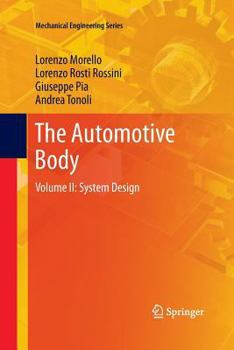The Automotive Body: Volume II: System Design
Select Format
Select Condition 
Book Overview
7 INTRODUCTION TO VOLUME II; 8 FUNCTIONS AND SPECIFICATIONS; 8.1 Transportation statistics; 8.2 Vehicle functions .; 8.3 Requirements measurement; 8.4 Regulations; 9 ERGONOMICS AND PACKAGING; 9.1 Hints on Physiology; 9.2 Manikins for interior packaging; 9.3 Hints of occupants positioning; 9.4 Pedals functionality and positioning; 9.5 Interior packaging; 9.6 Seat characteristics; 9.7 Accessibility; 9.8 Commands reach; 9.9 Loading and unloading; 9.10 Visibility; 10 CLIMATIC COMFORT; 10.1 Physiology outline; 10.2 Passenger compartment energy balance; 10.3 HEVAC System design and testing; 11 NOISE, VIBRATION, HARSHNESS; 11.1 Sensitivity to noise; 11.2 Sources of noise and vibration; 11.3 Dynamic behavior of the car body and modal analysis; 11.4 Engine suspension; 11.5 Acoustic transmission and insulation; 12 STRUCTURAL INTEGRITY; 12.1 Internal and external loads; 12.2 Behavior of thin wall structures; 12.3 Simplified structural models; 12.4 Numerical models for structural analysis; 12.5 Measurement of the car body stiffness; 13 PASSIVE SAFETY; 13.1 Biomechanics; 13.2 Simplified models for crash; 13.3 INTRODUCTION ON IMPACT ENERGY ABSORBERS; 13.4 FRONT STRUCTURE CONFIGURATION; 13.5 TESTING ON VEHICLES; 13.6 IMPACT TESTS EQUIPMENT; 13.7 NON LINEAR FEM ANALYSIS; 13.8 Simplified models for crash; 13.9 INTRODUCTION ON IMPACT ENERGY ABSORBERS; 13.10FRONT STRUCTURE CONFIGURATION; 13.11TESTING ON VEHICLES; 13.12IMPACT TESTS EQUIPMENT; 13.13NON LINEAR FEM ANALYSIS; References; INDEX;





